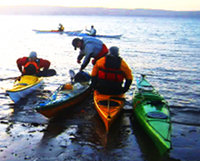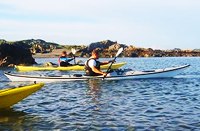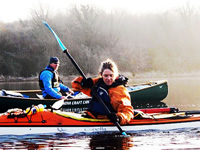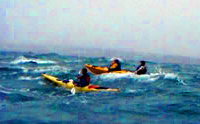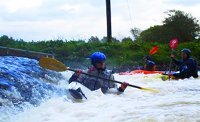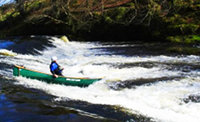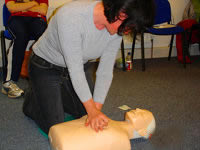Developing skills
Belfast Kayak Club run regular training sessions to help club members work on their skills.
We encourage all club members to attain British Canoeing personal skills awards. These help each individual determine the areas they need to work on to become more proficient. They are also useful for trip leaders / coaches because they provide a guideline of what the group members are capable – which helps them plan a suitable trip.
We aim to help club members develop skills in the following areas:
Technical Ability
- Lifting, carrying and launching
- Forward paddling, reverse paddling and stopping
- Maintain an active posture
- Turning using sweep strokes, edging & looking where you are going
- Paddle straight courses and figure-of-8 courses
- Moving the craft sideways using draw strokes
- Keeping the craft straight using the stern rudder
- Preventing a capsize using support strokes
- Returning to the bank or beach and disembarking
Safety
- Personal Protective Equipment
- How to use a buoyancy aid and helmet
- The basics of a kayak and paddle
- Appropriate personal clothing – windproof & waterproof clothes
- Exposure bags & emergency shelters
- Water Confidence
- Capsize drill – swim ashore; retain equipment; empty; (assisted) re-entry
- Rescues & being rescued
More advanced paddling techniques
- Controlling a turn using strokes on the inside of the turn
- Breaking into and out of a current
- S-transitions in surf or in a current
- Ferry gliding across a current
- Surfing a wave
- Paddling into and out of stoppers
- Learning to roll
- Contact tows & using a tow-line
Lifting, carrying & launching
Paddlers should always practice safe lifting and carrying principles, avoiding twisting when lifting. Paddlers should work towards the spine in line ethos and keep the load close to the body. Assistance from other paddlers is recommended at all times.
Paddlers should know how to alter the position of the footrest, backrest and where practical the seat.
Paddlers should be able to launch their craft from a variety of bank types, including slipways, jetties and beaches.
Once at the water, the paddler’s boat should be floating and entry into it should be achieved without aid from the paddle. The paddle needs to be close enough to reach once in the boat.
It is a common misconception that you need your spraydeck fitted before you launch. This is frequently not the case, especially when sea-kayaking in calm conditions. It can often be better to climb into a floating sea-kayak and paddle away from shore before fitting your spraydeck.
Paddlers should demonstrate that they have planned ahead and have positioned according to direction of travel when leaving the bank. The paddler should use draw strokes, short power strokes and rudders to manoeuvre away from the bank.
Efficient forward paddling
90% of the time in a kayak is spent paddling forwards, especially when sea-kayaking, so developing an effective and efficient forward paddling stroke that maximizes power transfer is a very important skill that can take a long time to master.
Forward paddling should
- Use an active posture, engaging the larger muscles of the body
- Develop rotational trunk movement from the seat/hips upwards, built around strong connections between paddle shaft and upper trunk
- Concentrate on smooth power transfer from paddle to boat with no excessive bobbing of boat or body
- Drive the paddle into the water with an extended front arm, have an appropriate grip and use leg pressure to help engage core rotation
Steering & controlling
Paddlers should be able to stop their kayak moving within 4 strokes.
Paddlers should be able to paddle backwards 20m to a fixed point, e.g. to rescue a capsized kayaker without having to turn the craft around. It is important to use the same body rotation and look where you are going.
Paddlers should be able to hold their kayak on edge to adjust a heading when forward paddling, to both the left and right, with the boat tracking a course and maintaining forward movement.
Controlled edged turns should always be initiated with a forward sweep.
Paddlers should be able to steer by keeping the boat straight through a narrow gap, e.g. 2 boat widths, by use of a trailing paddle in a stern rudder when starting from a good running speed.
Paddlers should be able to move the boat sideways around 5m using classic and sculling draw strokes without excessive swing, to both left and right. The active blade should remain submerged throughout the stroke.
Turning the boat in a fixed position should be accomplished using forward and reverse sweeps; body rotation needs to be evident. The craft should be held on edge on the sweep side.
Turning the boat whilst on the move, should be accomplished using controlled edged turns, initiated using a forward sweep, with the aim being to perform a selection of smooth wide and tight turns at 90°, 180°, 270° and 360°, rotating in both directions, e.g. following a figure of 8 course. Strokes that kill momentum should be avoided, e.g. the reverse pry.
Safety & rescue skills
Paddlers should understand the factors that contribute to hypothermia or hyperthermia and have strategies to avoid them. They should be able to deal with the most likely paddlesport injuries.
Paddlers should show an efficient low recovery stroke, on both sides, with the paddler off balance.
Paddlers must capsize the boat, with a spray deck in place, and show no sign of panic. They then should rescue themselves by one or other of these suitable methods; climb back in and bail, or swim ashore with all their equipment and empty.
Paddlers should demonstrate helping a peer get back into their boat after a capsize. Suitable methods would include; x-rescue, heel hook, or tow/shunt to the shore as appropriate.
Trip planning
Paddlers should be able to plan and execute a paddle journey for up to 5 paddlers, lasting up to an hour, in less than 20Km/h wind.
Things to think about
- the start and finish locations
- the environment : river, lake, bay, etc.
- weather forecast, wind, tides, current strength, river levels
- kit list, and who has what - everybody does not need to carry everything
- anticipated hazards, anticipated timings and emergency procedures
Questions you should know the answer to
- What materials are most modern boats made from?
- Why should you wear some form of wind/waterproof?
- Why is it important to wear a buoyancy aid when on or near the water?
- What clothing would you wear in cold weather and why?
- Why is the wind direction important when considering where and if you should go paddling?
- How would the tide or current flow be used to help make progress easier?
- Who should you contact before heading out on the water?
- What is a shuttle with regards to a sea kayaking journey?
And most importantly, learn to have fun on the water!
